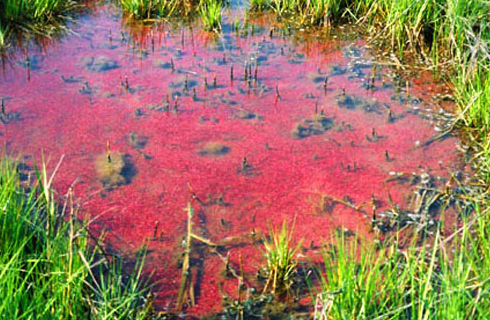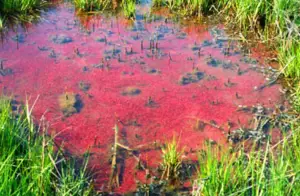These are the group of anaerobic bacteria that are capable of photosynthesis. They may be Microaerophillic bacteria. These bacteria are divided into two groups i.e. the Chromatiaceae and the Ectothiorhodospiraceae. They are different in their internal membranes structure and presence of extracellular or intracellular sulfur granules.
Examples of Purple Sulfur Bacteria:
Nitrosococcus
Characteristics:
The characteristics of purple sulfur bacteria are as follows.
- They are anaerobic or Microaerophillic bacteria that is they use either no or a small amount of air.
- Unlike cyanobacteria, they use reduced sulfur to produce sulfur.
- They sulfur oxidize into sulfur granules that are present inside or outside the cell.
- They are present in stagnant water and hot springs.
- Hydrogen sulfide forms the bloom of purple sulfur bacteria.
- They have bacterial chlorophyll with carotenoids that give them various colours such as purple, pink etc.
- Their photosynthesis occurs in the cell membrane where photosynthetic pigments are present in the form of vesicles and stacks.
Physiology:
These bacteria use reduce sulfur as electron donor as they can’t use oxygen. They produced hydrogen sulfide that produces rotten egg smell. They are photosynthetic in nature as they can fix the inorganic carbon into glucose. They can use light energy to get energy and fix CO2
CO2 + H2S C6H12O6 + S
They produce granules that can be observed under 1000X microscope. They give purple to pink colour to the water. They grow in dark places.
Metabolism:
They are mainly photoautotrophic that is they can synthesize or prepare their own food. But some are chemoautotrophic that they use the chemical to get energy. They may be photoheterotrophic that can’t fix carbon into its food but get energy from light. They are strict anaerobic bacteria but some of them are good fermenters.
Ecological importance:
The ecological importance of purple sulfur bacteria is as:
- They take part in nutrient cycles.
- They play an important role in primary production as they can fix the carbon.
- They recycle the phosphorus cycle for heterotrophic bacteria to use.
- These bacteria can use as food for other organisms.
- These bacteria release excess light as heat energy.
Bioremediation:
These bacteria can reduce harmful waste from the environment. Purple sulfur bacteria lower the amount of hydrogen sulfide, methane and toxic compound present in water lagoons.
Hydrogen sulfide is used as a source of sulfur for the purple sulfur bacteria while methane is used as the source of carbon for these bacteria. Thus, purple sulfur bacteria lower the odour and toxicity of the water.


